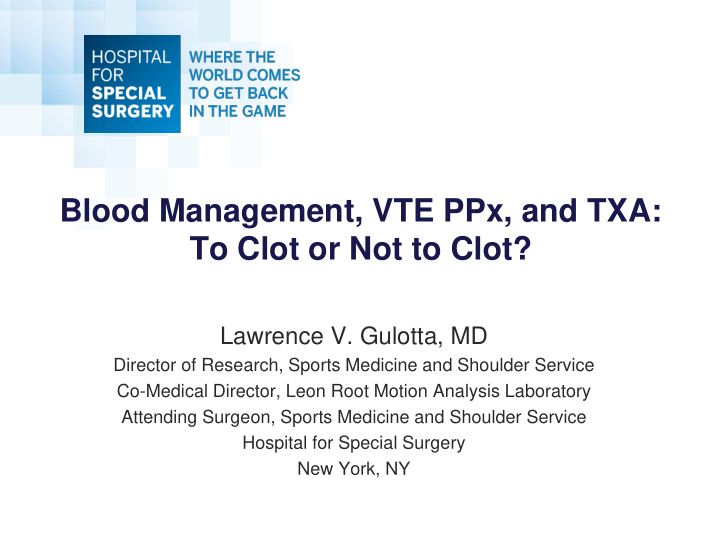



Blood Management, VTE PPx, and TXA: To Clot or Not to Clot? Lawrence V. Gulotta, MD Director of Research, Sports Medicine and Shoulder Service Co-Medical Director, Leon Root Motion Analysis Laboratory Attending Surgeon, Sports Medicine and Shoulder Service Hospital for Special Surgery New York, NY
Disclosures Zimmer-Biomet, Inc – Speaking and Consulting
You Should Do Something
Shoulder Arthroplasty
Shoulder Arthroplasty Willis et al. JSES 2009 100 consecutive patients Surveillance 4 Extremity U/S at POD#2 and 12 weeks 13% had DVT 2% had non-fatal PE Mechanical Boots and ECASA 1% fatal PE Initiated Similar to THA
Shoulder Arthroplasty Follow-Up Study Bedi et al. AAOS 2010 178 patients Surveillance U/S done at 6 and 12 weeks. 2.2% had DVT at 6 weeks 0.6% had DVT at 12 week 0% PE
Shoulder Arthroplasty Mayo Registry 2885 Patients 5 PE’s (0.17%) 0 Fatal
Shoulder Arthroplasty Navarro et al. CORR 2013 Retrospective database review 2574 eligible patients, All types of arthroplasty All Patients: – 0.51% DVT – 0.54% PE Trend towards more frequent in trauma patients
Shoulder Arthroplasty Jameson et al. JSES 2011 UK Database – 4,061 cases DVT: 0% PE: 0.2% Mortality: 0.22%
VTE is There if You Look for It Rarely Clinically Relevant (though not zero) Should You Go Looking?
Surveillance Dopplers? Schwarcz et al. Ann Vasc Surg. 2004. 441 THA and TKA’s U/S within 1 Week 5 Positive (1.3%) 3 Had PE – two of which had a negative surveillance Doppler. No Role for Surveillance U/S
What Makes a Patient High Risk?
Virchow’s Triad
High Risk Patients •High Risk = 2 or More Factors
Options for DVT PPx •www.webmd.com
Recommendations at HSS Shoulder Arthroplasty Moderate Risk Procedure –High Risk Patient (h/o –Low Risk Patient VTE, 2 or more risk •Plexipulse factors) •ECASA 325mg BID 6 •Coumadin/Lovenox weeks •Xeralto becoming more •No surveillance imaging common
Blood Management “ Do I need to donate blood? ”
Blood Management National Heart, Lung and Blood Institute (NHLBI) –Pre-op donation if risk is >10% of transfusion
Blood Transfusions – Millett et al. JBJS 2006 –25% of 124 TSA ’ s needed transfusion –Strongest Predictor: pre-op Hb < 110 g/L –78% of Autologous units wasted •90% of patients with pre-op Hb > 130 g/L Do Not Recommend Pre-Op Donation
Blood Transfusions – 366 Shoulder Risk Factors Arthroplasties –Low Pre-op Hgb –High blood loss – 7.4% Transfusion Rate –Humeral cement fixation
Blood Transfusions – Mayo, JSES 2014 Risk Factors –Age • 566 Revision –> 5 hrs OR time Arthroplasties –Humeral revision • 11.3% Transfusion rate –Low Pre-Op Hgb –Diabetes –CAD
Tranexamic Acid “Standard of Care” for THA, TKA - Topical - IV - Oral
Tranexamic Acid
Tranexamic Acid TXA has drastically reduced transfusions in Hip and Knee Arthroplasty, and data shows it to do the same for S houlder. Drain Output – Cleveland – 170mL vs 108mL – 110 Patients Does not appear to increase the risk of VTE Hgb Loss Post-Op • Randomized Though not used in “ high risk” VTE patients – 2.6 g/dL vs 1.7 g/dL No transfusion either group • Placebo with Saline • 2g Topical TXA
Recommendations at HSS Strongest factor that predicts post-op transfusion is pre-op Hgb Ironically, also contraindication for pre-op blood donation Do not routinely recommend autologous donation If pre-op Hbg < 11 g/dL, refer back to PMD/Heme for pre-op optimization. • Iron, nutrition, possible Epo TXA now routinely used IV Given with pre-op Abx Drastically reduced transfusions.
Thank You
Recommend
More recommend